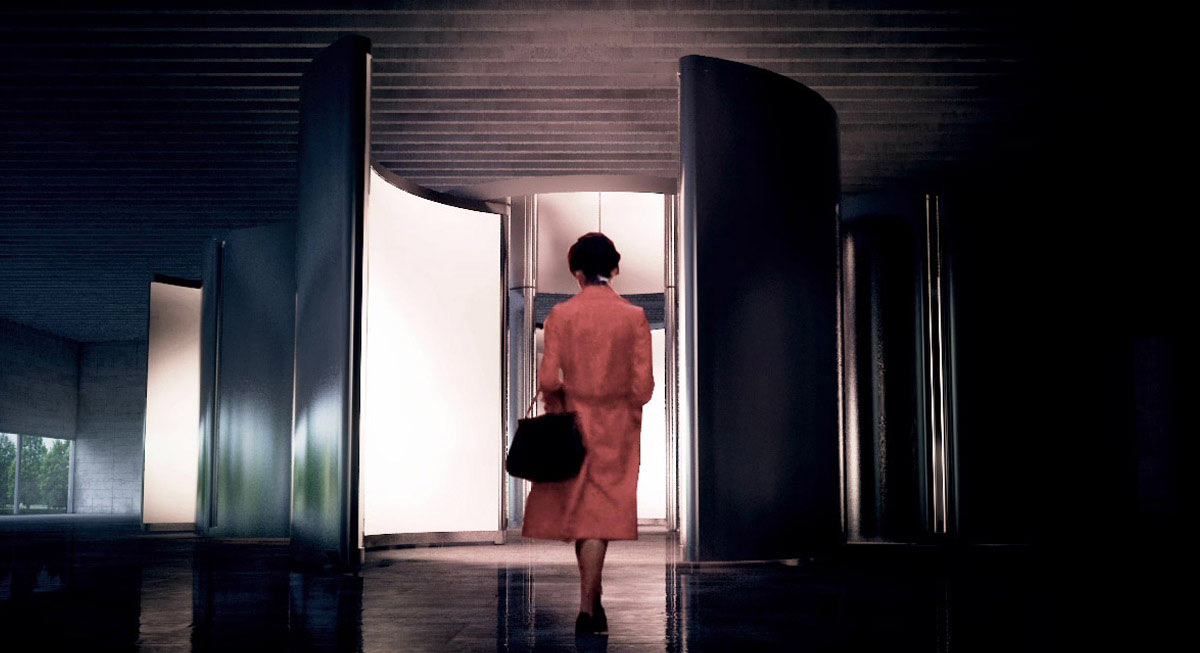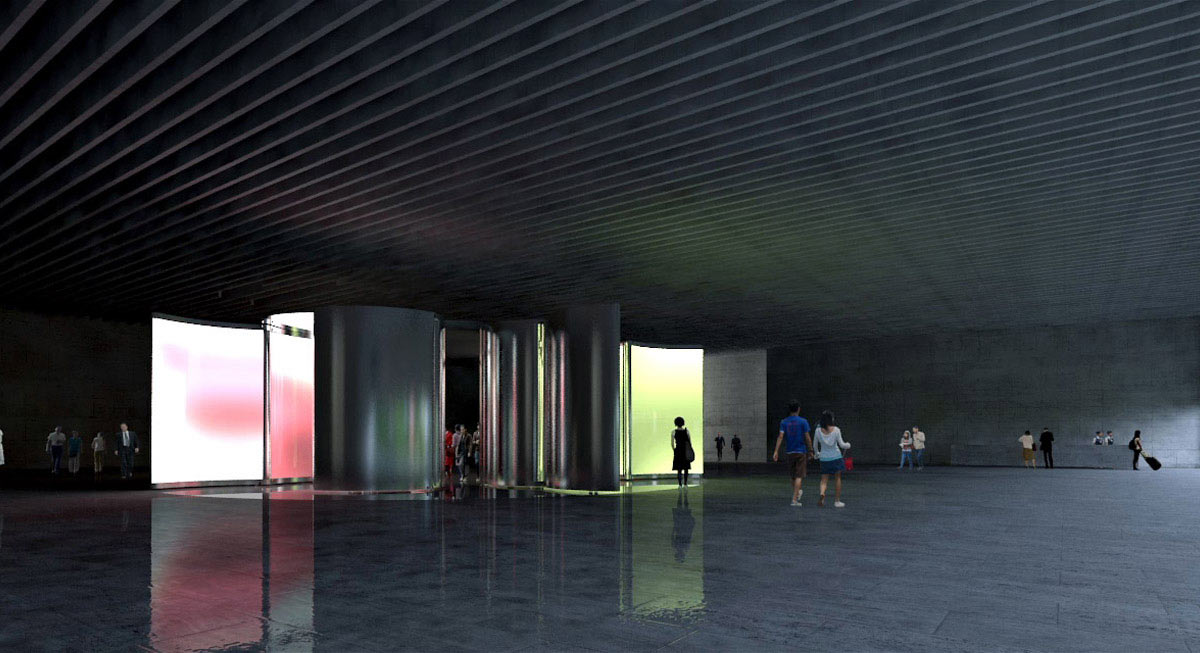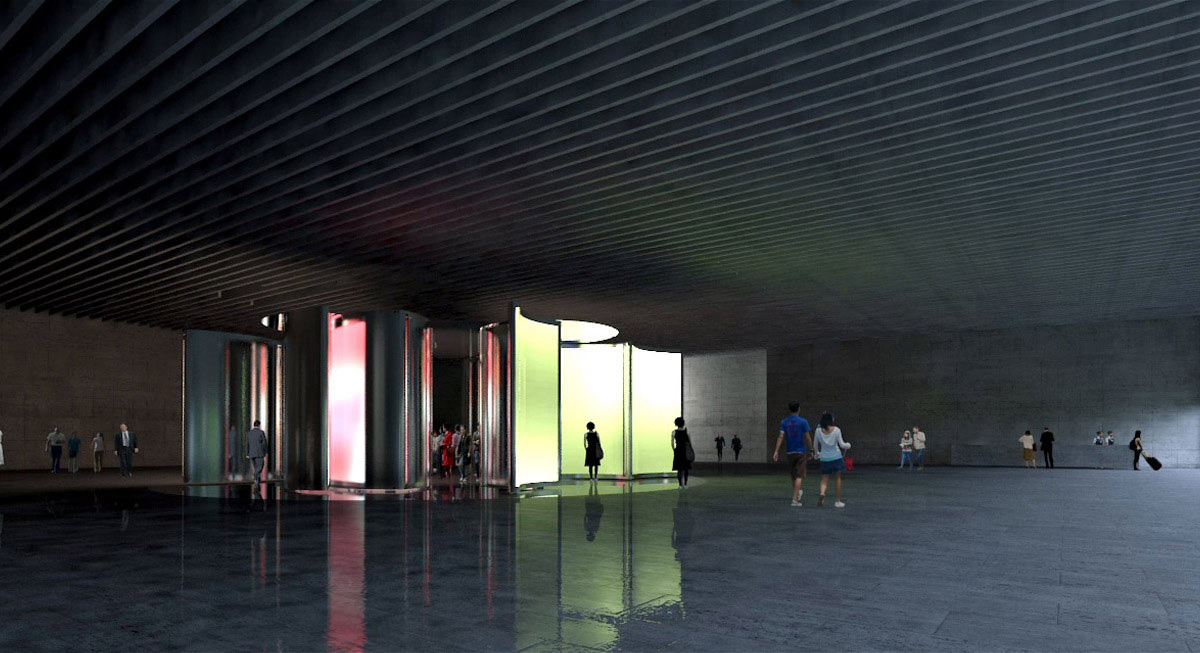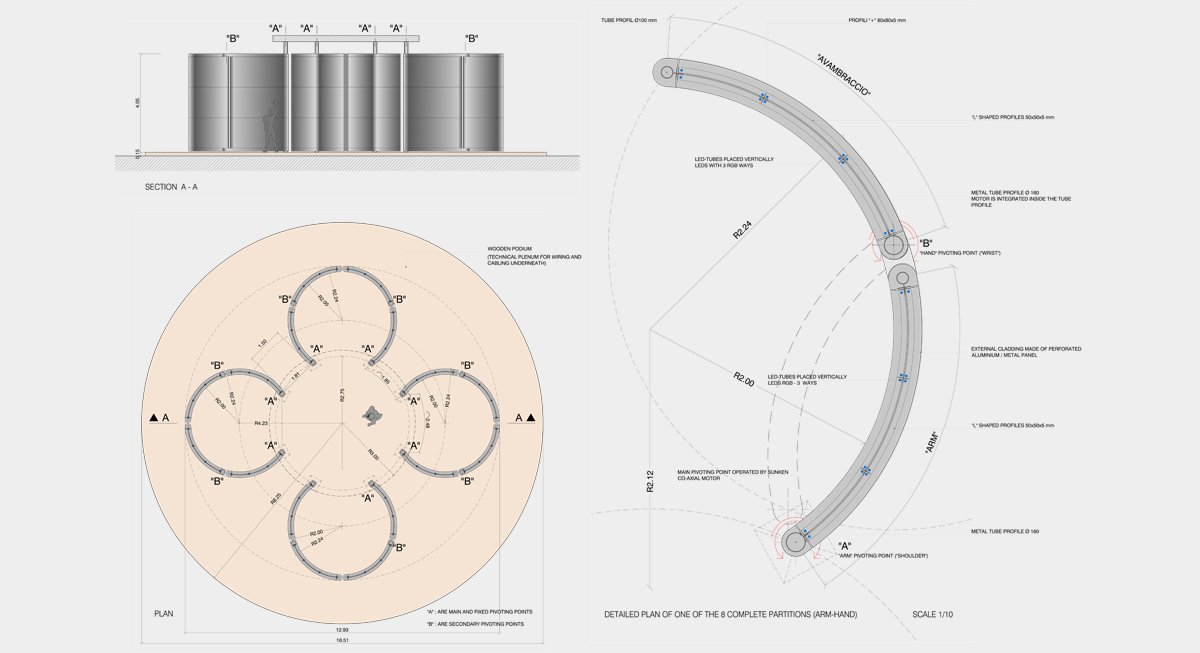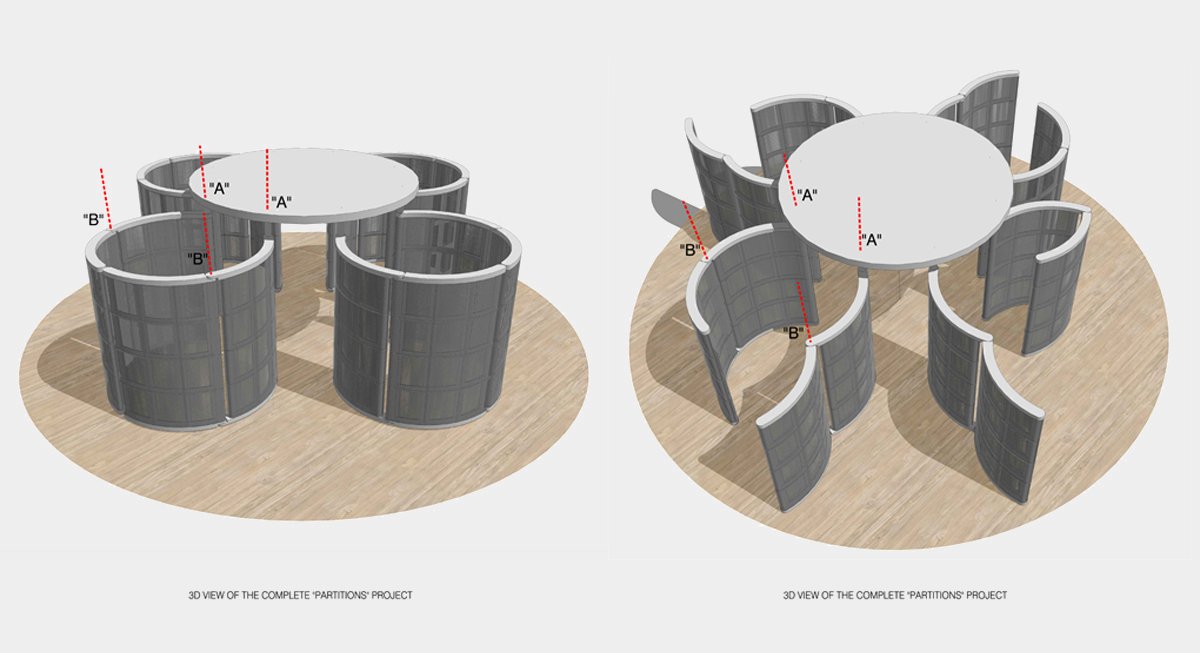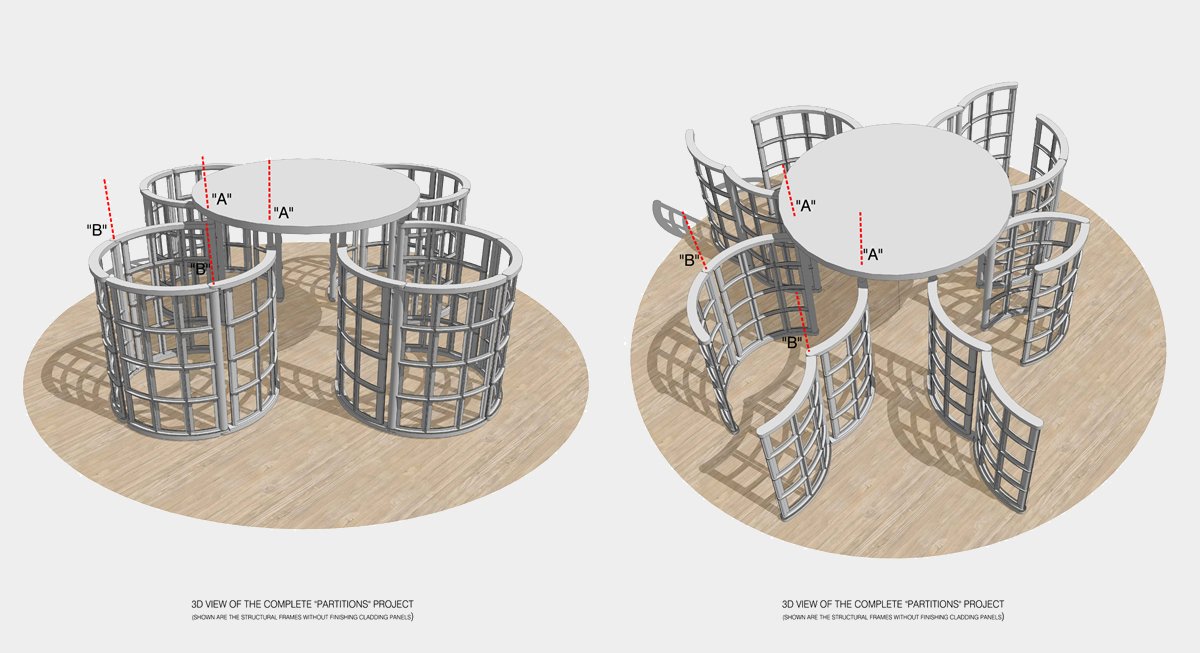
PROGRAM : Art installation for generative and interactive architecture and music
APPOINTMENT : Architect and Design
DATE : 2013
Partitions is a dynamic, generative and interactive architecture, that moves in real time diffusing music, sound and lights.
Partitions takes the time duration of onewhole day to describe all of its movements.
From its origin, the formations change in a continuous movement returning at the end of the day to its original shape.
Partitions is an architectural "breath”, cyclical in its nature. The cyclical movements suggest a continuous rebirth, a continual return to its origin. These movements are enriched by the presence of the people who, by their movement or simple presence, can modify the elements behavior and speed, thus affecting their own perception of time.
Partitions is a stage "machina" that plays music, light and architecture.
It's a space for listening to generative music, composed following the same criteria of the architectural composition : a generative and interactive music for an always moving and dynamic public.
Partitions stems from the idea to have architectural composition and music become necessary to each other.
The public becomes an aware and active interpreter.
Musicand architecture are inextricably and intrinsically connected to offer to the audience an experience that goes beyond the horizon of simply “being in a given space” or simply “listening to a given music”.
Partitions offers to the public the experience of a new way of perceiving architectonics and sound.
The architecture is based on a symmetrical cruciform plan.
The intention is to adopt a geometrical archetype, a totem, a-temporal and familiar to every culture in any historical moment : the "Something" so well known that people will not focus on its shape but on its movements.
Each one of the 8 mobile elements of Partitions is composed by a “hand” and an “arm”, articulated on a “shoulder”. These 8 parts unfold around 8 fixed points, “shoulders”, placed on orthogonal axes.
The precise cardinality of the space structures the continuous movements of the “arms”.
Partitions uncovers and reveals its geometrical form only in its starting position, with all the walls closed.
The architect writes a composition for generative architecture that modifies itself following a generative system depending on the presence and movements of the public inside and outside of Partitions.
In a way Partitions is a utopic definition of the space, because the only way of apprehending its geometry is to look at Partitions for a whole day long.
Music and sound change with the movements of architecture.
Music is based on generative and interactive models, pre-composed but open to change following varying perturbations and interpolations. In this sense, Partitions evokes the movements of the weaves on a shoreline. Everything that is designed in the space and "sung" by Partitions does not remain. The presence of one formation wipes away the previous thus raising the notion of ephemeral of what you are looking at and that you feeling of.
Music and space reveal themselves as "consistent" generative models that are not perceived as fixed forms but through their movements.
Partitions allows a sort of "transgression" : you can touch it! Touching a wall changes its direction.The space can be modulated not only by the presence of one person but also by his decisions. Nothing is quite random as it is always a question of choice,the choice of the architect as per the time evolution of the space, the choice of the music composer, the choice of the public to enter these spaces and/or to modify them by its presence and choice of direction, duration, and speed of its movements.
In Partitions “listening to” has two distinct dimensions : sounds and music. On one hand a generative and interactive music (based on the same criteria of the architecture) is diffused by the walls themselves : melodies, harmonies, rhythmic sequences, etc. On the other hand a sound environment is constantly mixed such as a musical background. The more the audience moves from one section to another and the more Partitions unfolds music. Where no one is moving, a background sound becomes predominant. Where the audience moves through the space of Partitions, a richer music articulates itself following the “behavior” and the movements of Partitions’ articulated walls.
Partitions is a machine of light, music and architectural movements that draws spaces, opens unexpected perspectives, creates unforeseen sequences, changing spatial relationships in a continuous dynamic design.
Partitions produces aesthetic moments through continual revelation, epiphany of new sounds, new forms, new spaces, within one and same environment.
Partitions has the ability to create a "suspended time perception" thanks to the questioning of our habitual orientation parameters. Whatever we know about how to behave in a given space, where to look at and whatto listen tois redefined. What we know “a priori” shifts to a new artistic dimension : Partitions opens the public tothe unexpected, the unpredictable, and the ever-changing.
APPOINTMENT : Architect and Design
DATE : 2013
Partitions is a dynamic, generative and interactive architecture, that moves in real time diffusing music, sound and lights.
Partitions takes the time duration of onewhole day to describe all of its movements.
From its origin, the formations change in a continuous movement returning at the end of the day to its original shape.
Partitions is an architectural "breath”, cyclical in its nature. The cyclical movements suggest a continuous rebirth, a continual return to its origin. These movements are enriched by the presence of the people who, by their movement or simple presence, can modify the elements behavior and speed, thus affecting their own perception of time.
Partitions is a stage "machina" that plays music, light and architecture.
It's a space for listening to generative music, composed following the same criteria of the architectural composition : a generative and interactive music for an always moving and dynamic public.
Partitions stems from the idea to have architectural composition and music become necessary to each other.
The public becomes an aware and active interpreter.
Musicand architecture are inextricably and intrinsically connected to offer to the audience an experience that goes beyond the horizon of simply “being in a given space” or simply “listening to a given music”.
Partitions offers to the public the experience of a new way of perceiving architectonics and sound.
The architecture is based on a symmetrical cruciform plan.
The intention is to adopt a geometrical archetype, a totem, a-temporal and familiar to every culture in any historical moment : the "Something" so well known that people will not focus on its shape but on its movements.
Each one of the 8 mobile elements of Partitions is composed by a “hand” and an “arm”, articulated on a “shoulder”. These 8 parts unfold around 8 fixed points, “shoulders”, placed on orthogonal axes.
The precise cardinality of the space structures the continuous movements of the “arms”.
Partitions uncovers and reveals its geometrical form only in its starting position, with all the walls closed.
The architect writes a composition for generative architecture that modifies itself following a generative system depending on the presence and movements of the public inside and outside of Partitions.
In a way Partitions is a utopic definition of the space, because the only way of apprehending its geometry is to look at Partitions for a whole day long.
Music and sound change with the movements of architecture.
Music is based on generative and interactive models, pre-composed but open to change following varying perturbations and interpolations. In this sense, Partitions evokes the movements of the weaves on a shoreline. Everything that is designed in the space and "sung" by Partitions does not remain. The presence of one formation wipes away the previous thus raising the notion of ephemeral of what you are looking at and that you feeling of.
Music and space reveal themselves as "consistent" generative models that are not perceived as fixed forms but through their movements.
Partitions allows a sort of "transgression" : you can touch it! Touching a wall changes its direction.The space can be modulated not only by the presence of one person but also by his decisions. Nothing is quite random as it is always a question of choice,the choice of the architect as per the time evolution of the space, the choice of the music composer, the choice of the public to enter these spaces and/or to modify them by its presence and choice of direction, duration, and speed of its movements.
In Partitions “listening to” has two distinct dimensions : sounds and music. On one hand a generative and interactive music (based on the same criteria of the architecture) is diffused by the walls themselves : melodies, harmonies, rhythmic sequences, etc. On the other hand a sound environment is constantly mixed such as a musical background. The more the audience moves from one section to another and the more Partitions unfolds music. Where no one is moving, a background sound becomes predominant. Where the audience moves through the space of Partitions, a richer music articulates itself following the “behavior” and the movements of Partitions’ articulated walls.
Partitions is a machine of light, music and architectural movements that draws spaces, opens unexpected perspectives, creates unforeseen sequences, changing spatial relationships in a continuous dynamic design.
Partitions produces aesthetic moments through continual revelation, epiphany of new sounds, new forms, new spaces, within one and same environment.
Partitions has the ability to create a "suspended time perception" thanks to the questioning of our habitual orientation parameters. Whatever we know about how to behave in a given space, where to look at and whatto listen tois redefined. What we know “a priori” shifts to a new artistic dimension : Partitions opens the public tothe unexpected, the unpredictable, and the ever-changing.
AUTHORS :
Jacopo Baboni-Schilingi, Music composer
http://www.baboni-schilingi.com
Pier Luigi Copat, PLC Architectures, Architect
Jacopo Baboni-Schilingi, Music composer
http://www.baboni-schilingi.com
Pier Luigi Copat, PLC Architectures, Architect

